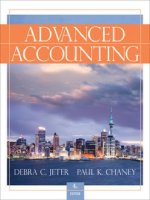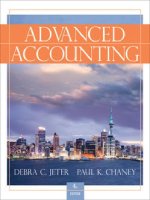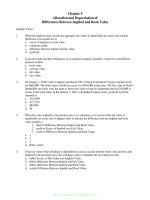advanced accounting 6e by jeter chaney chapter 19
Bạn đang xem bản rút gọn của tài liệu. Xem và tải ngay bản đầy đủ của tài liệu tại đây (526.77 KB, 50 trang )
Advanced Accounting
Jeter ● Chaney
Accounting For Nongovernment
Nonbusiness Organizations: Colleges
And Universities, Hospitals And Other
Health Care Organizations
1
Prepared by Sheila Ammons, Austin Community College
Learning Objectives
•
•
•
•
•
•
•
Describe the source of accounting standards for nongovernment nonbusiness organizations
(NNOs).
Identify the three basic statements for NNOs.
Describe the basic funds used by nongovernment nonbusiness organizations.
Distinguish between a current restricted fund and an unrestricted fund.
Explain the term “assets whose use is limited.”
Distinguish between a mandatory and a nonmandatory transfer.
Explain how contributions are recorded by NNOs.
2
Copyright © 2015. John Wiley & Sons, Inc. All rights reserved.
Learning Objectives
•
•
•
•
•
•
•
Understand how donated services are recorded.
Describe the funds used to account for property, plant and equipment.
Explain the basic accounting used by endowment funds.
Indicate how equity investments are reported in the financial statements.
Explain the change in accounting for loan funds brought about by new standards.
Understand the use of an annuity or life income fund.
Discuss the special reporting issues of hospitals.
3
Copyright © 2015. John Wiley & Sons, Inc. All rights reserved.
Nongovernment Nonbusiness Organizations (NNOs)
•
Four Major Classifications of NNOs:
– Nonprofit institutions of higher education.
– Hospitals and other health care providers.
– Voluntary health and welfare organizations (VHWOs).
– Other nongovernment nonbusiness organizations (ONNOs).
4
Copyright © 2015. John Wiley & Sons, Inc. All rights reserved.
Hierarchy of Reporting Standards (NNOs)
•
The hierarchy used to establish generally accepted reporting standards for NNOs other than
government-owned special entities
–
–
•
is the same as that for profit oriented business organizations
and included in the FASB Codification.
FASB standards for nonprofits are found in FASB ASC Topic 958, Not-for-Profit Entities.
LO 1 The source of accounting standards.
5
Copyright © 2015. John Wiley & Sons, Inc. All rights reserved.
Financial Reporting for Not-for-Profit
•
Three basic financial statements required:
1)
2)
3)
Statement of financial position (balance sheet)
•
Net Asset categories:
–
–
Unrestricted net assets
–
Permanently restricted net assets – endowments: interest might be spend but
not the principal.
Temporarily restricted net assets – resources that must be used for a specific
purpose or in a specific time period (restriction is donor imposed).
Statement of activities
Statement of cash flows
LO 2 Three basic financial statements.
Copyright © 2015. John Wiley & Sons, Inc. All rights reserved.
6
Fund Accounting
•
•
Most NNOs use fund accounting for recordkeeping and reporting purposes.
Six funds commonly used:
– Current Fund (restricted and unrestricted).
– Plant Fund.
– Endowment Fund.
– Loan Fund.
– Agency or Custodial Fund.
– Annuity and Life Income Fund.
LO 3 Basic funds used by NNOs.
Copyright © 2015. John Wiley & Sons, Inc. All rights reserved.
7
Accrual Basis of Accounting
•
Financial statements for NNOs (accrual basis)
•
For external reporting purposes,
– Revenues are reported when earned and realized or realizable, and
– Expenditures are reported when materials or services are received,
– Expenses incurred before the reporting date are accrued,
– Expenses applicable to future periods are deferred.
– Revenues are classified by source, and
– Expenses and expenditures are classified by function or activity.
8
Copyright © 2015. John Wiley & Sons, Inc. All rights reserved.
Accounting for Current Funds
•
Current Unrestricted Funds
Financial resources that may be expended at the discretion of the governing board
Current Restricted Funds
Resources restricted because of legal, contractual, or external restrictions on their use.
Current unrestricted resources may be expended at the discretion of the governing board, whereas current restricted resources
may be expended only in accordance with externally imposed restrictions.
LO 4 Distinguish between restricted and unrestricted funds.
Copyright © 2015. John Wiley & Sons, Inc. All rights reserved.
9
Accounting for Current Funds
Accounting for Board Designated Funds
– Part of current unrestricted fund.
– Resources designated by governing board for specific purposes, projects, or investments.
– Aid in planning and control of expenditures and limit discretion of management.
– Governing board can reverse or modify designations.
Do not confuse these designations with donor or external restrictions on the use of
resources
LO 4 Distinguish between restricted and unrestricted funds.
Copyright © 2015. John Wiley & Sons, Inc. All rights reserved.
10
Accounting for Current Funds
Assets Whose Use is Limited
•
•
Hospitals = classified as assets whose use is limited.
Assets set aside by the governing board of a hospital for board-designated purposes.
– Assets whose use is limited under terms of debt indentures, trust agreements, third-party
reimbursement arrangements, or similar arrangements are also presented as assets whose
use is limited.
LO 5 Assets whose use is limited.
Copyright © 2015. John Wiley & Sons, Inc. All rights reserved.
11
Accounting for Current Funds
•
Colleges and Universities
– Board designated funds for specific current operating purposes are accounted for by
footnote or by reclassification of the Unrestricted Current Fund Balance.
– Some board-restricted current resources can be transferred to other funds.
LO 4 Distinguish between restricted and unrestricted funds.
12
Copyright © 2015. John Wiley & Sons, Inc. All rights reserved.
Accounting for Current Funds
Mandatory and Nonmandatory Transfers
•
•
Unique to colleges and universities
•
Nonmandatory transfers
Mandatory transfers
– Transfers from Current Funds group to other fund groups arising from
• binding legal agreements
• grant agreements
– Transfers from Current Funds group to other fund groups at discretion of governing board.
LO 6 Mandatory vs. nonmandatory transfers.
13
Copyright © 2015. John Wiley & Sons, Inc. All rights reserved.
Contributions
•
All NNOs under FASB jurisdiction are required to recognize contributions as revenue in the
period received.
– This includes unconditional promises to give.
– The standard does not apply to tax exemptions, abatements or incentives, or to transfers of
•
•
assets from a government to a business enterprise.
Contributions include gifts of cash, pledges, donated services, and gifts of noncash assets.
Conditional promises to give are recognized when they become unconditional (when the
conditions are substantially met).
LO 7 How contributions are recorded.
Copyright © 2015. John Wiley & Sons, Inc. All rights reserved.
14
Contributions
•
Pledges are recorded as revenues when a promise to give is nonrevocable and unconditional, at
present value of expected receipts.
– Pledges are signed commitments to contribute specific amounts of money to an
organization on a future date or in installments.
– Although resembling promissory notes, pledges generally are not enforceable contracts.
– All NNOs should establish an allowance for uncollectible pledges.
LO 7 How contributions are recorded.
Copyright © 2015. John Wiley & Sons, Inc. All rights reserved.
15
Contributions
•
•
Exercise 19-6: A well-known celebrity sponsored a telethon for the Help for the Blind
Foundation on November 1, 2015. Pledges in the amount of $1,000,000 were called in. Using
similar telethon campaigns as a basis, it is estimated that 25% of the pledges will be
uncollectible. During 2016, $700,000 of contributions from these pledges were collected. The
remainder were uncollectible.
Required: Identify the appropriate fund(s) and prepare the journal entries necessary in 2015
and 2016 to record these transactions.
LO 7 How contributions are recorded.
Copyright © 2015. John Wiley & Sons, Inc. All rights reserved.
16
Contributions
Exercise 19-6: Prepare the journal entries necessary in 2015.
Current Unrestricted Fund
Pledges Receivable
1,000,000
Revenue - Contributions
1,000,000
Expense - Provision for Uncollectible Pledges
250,000
Allowance for Uncollectible Pledges
250,000
LO 7 How contributions are recorded.
Copyright © 2015. John Wiley & Sons, Inc. All rights reserved.
17
Contributions
Exercise 19-6: Prepare the journal entries necessary in 2016.
Cash 700,000
Pledges Receivable
700,000
Expense - Provision for Uncollectible Pledges
50,000
Allowance for Uncollectible Pledges
250,000
Pledges Receivable
300,000
LO 7 How contributions are recorded.
Copyright © 2015. John Wiley & Sons, Inc. All rights reserved.
18
Contributions
Donated Services
•
Recognized only if the services received:
– Create or enhance nonfinancial assets, or
– a. Require specialized skills,
b.
Are provided by individuals possessing those
c.
Would need to be purchased if not provided
skills, and
by donation.
Recorded as revenue or support with an amount equal to the revenue recognized as an expense in the appropriate expense account.
LO 8 How donated services are recorded.
Copyright © 2015. John Wiley & Sons, Inc. All rights reserved.
19
Contributions
Exercise 19-2: During 2015 volunteer pinstripers donated their services to General Hospital at no cost. The staff at
General Hospital was in control of the pinstripers’ duties. If regular employees had provided the services rendered by the
volunteers, their salaries would have totaled $6,000. While working for the hospital, the pinstripers received complimentary
meals from the cafeteria, which normally would have cost $500. Required: Prepare the journal entry necessary in the
General Fund to record the donated services on the books of General Hospital.
General Services Expense
5,500
Donated Services (Nonoperating Revenue)
5,500
20
Copyright © 2015. John Wiley & Sons, Inc. All rights reserved.
Contributions
Donor-Imposed Restricted Contributions
•
Recorded as contribution revenues in period received, thus increasing either temporarily or
permanently restricted net assets.
•
When expenditures are made, or restriction expires, net assets are released from temporarily (or
permanently) restricted net assets and are reported as unrestricted net assets on the Statement of
Activities.
LO 7 How contributions are recorded.
21
Copyright © 2015. John Wiley & Sons, Inc. All rights reserved.
Contributions
•
Exercise 19-3: The Franklin Public Library received a restricted contribution of $300,000 in
2015. The donor specified that the money must be used to acquire books of poetry written in the
sixteenth century. As of December 31, 2015, only $100,000 of the restricted resources had been
expended.
•
Required: Prepare the journal entries necessary to record these events during 2015. Indicate
the fund in which each journal entry is recorded.
22
Copyright © 2015. John Wiley & Sons, Inc. All rights reserved.
Contributions
Exercise 19-3: Prepare the journal entries necessary to record these events during 2015.
Restricted Current Fund
Cash
300,000
Contribution Revenue – Poetry Collection
300,000
Net Assets Released from Restrictions
100,000
Cash
100,000
Unrestricted Current Fund
Cash
100,000
Net Assets Released from Restrictions
100,000
Expenses – Poetry Collection
100,000
Cash
100,000
23
Copyright © 2015. John Wiley & Sons, Inc. All rights reserved.
Accounting for Plant Funds
The plant fund is used to account for
– property, plant and equipment (PP&E) owned by the organization and the net investment,
– accumulation of financial resources for acquisition or replacement of PP&E,
– acquisition and disposal of PP&E,
– liabilities relating to acquisition of PP&E, and
– depreciation expense and accumulated depreciation.
All types of NNOs are required by GAAP to record depreciation expense.
LO 9 Funds used to account for PP&E.
24
Copyright © 2015. John Wiley & Sons, Inc. All rights reserved.
Accounting for Plant Funds
College and Universities
•
Divided into four separate self-balancing subgroups:
– Unexpended Plant Fund
– Funds for Renewals and Replacements
– Funds for Retirement of Indebtedness
– Investment in Plant
Both board-designated funds and externally restricted funds are accounted for in the plant fund; therefore, a distinction is made between
restricted and unrestricted fund balances.
LO 9 Funds used to account for PP&E.
25
Copyright © 2015. John Wiley & Sons, Inc. All rights reserved.



